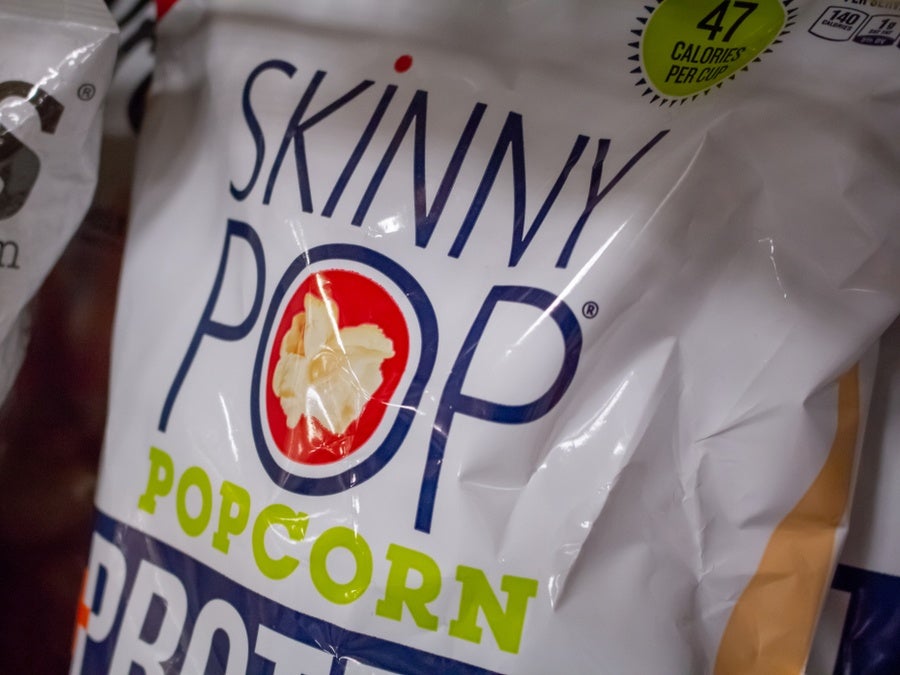
Hershey has massaged the confectionery and snacks maker’s sales outlook as consumers pulled back on less-than-essential spending.
Net sales in the three months to 30 June fell 16.7% to $2.08bn and were down 16.8% in organic terms, Hershey reported today (1 August).
Sales also dropped across the group’s North American confectionery and international business divisions. But the North America salty snacks segment bucked the trend as reported sales rose 6.4%, with volume-mix up 9% on the back of a 3% decrease in pricing.
Otherwise, it was a negative set of numbers for the New York-listed owner of brands such as Reese’s butter cups and SkinnyPop popcorn.
Michele Buck, the president and CEO of Pennsylvania-based Hershey, said that the “operating environment remains dynamic, with consumers pulling back on discretionary spending”.
She amended the sales guidance for the year to “about” 2% from 2-3% growth previously, an outlook that was kept unchanged when first-quarter numbers were provided in May.
For Hershey’s North America confectionery division, sales dropped 20.7% in reported terms and volume-mix slid 22%, even as pricing increased just 1%.
The international segment saw sales decrease 8.9% and 10.4% on a constant currency basis. Volume-mix was down 16% with pricing up 5%.
Buck continued: “Our business has been impacted by these trends but we are pleased to see continued growth in the confection category and momentum building in our salty snacks portfolio.
“Our second-half innovation is expected to bring energy to our categories and we are confident our evolving strategies will meet consumers’ changing needs and drive long-term success.”
Elsewhere, Hershey’s gross margin dropped 530 basis points on a reported basis to 40.2%, which the company put down to “derivative mark-to-market losses, higher commodity costs, and fixed-cost deleverage that more than offset price realisation, productivity gains and input-cost timing favourability”.
The adjusted gross margin fell 200 basis points to 43.2%.
Second-quarter operating profit was $287.8m, a decrease of 48.7% in reported terms from a year earlier. The operating profit margin declined 860 basis points to 13.9%.
Adjusted, operating profit decreased 32.8% to $383.5m, with the margin down 440 points at 18.5%.
Second-quarter earnings per share, adjusted and diluted, fell 36.8% to $1.27. Hershey tweaked the 2024 outlook for the metric to “down slightly” from flat previously.
However, reported EPS is expected to now be down by 1% to 3% for the year, compared to a previous expectation for an unchanged print. It fell 55.1% for the quarter to $0.89.
Hershey explained the dynamics behind the second-quarter sales declines as being connected to the new ERP system and inventories.
“Both consolidated and organic, constant currency net sales reflected an ~9 point decline from planned inventory reductions within North America confectionery and international related to the second quarter enterprise resource planning (ERP) system implementation, as well as an ~7 point decline from lower levels of retailer inventory and seasonal shipment timing within North America confectionery that is expected to shift to the second half of 2024.”
Robert Moskow, an analyst at US investment bank TD Cowen, said the market consensus for organic growth was minus 7.3%, while reported EPS of $1.27 was below expectations of $1.44.
“Management reduced guidance only modestly for the year because most of the miss came from a shift in timing of customer orders for seasonal merchandising into 3Q,” Moskow wrote in a research note.
“However, [the] category is weaker-than-expected and market share declined.”
Meanwhile, John Baumgartner at Mizuho Securities suggested any further cocoa-linked pricing could put further pressure on confectionery sales.
Discussing first-quarter results in May, CEO Buck was reluctant to provide some insight on the trajectory for cocoa into 2025, although she made some assurances over commodity coverage for this year.
Baumgartner, a managing director at the Japanese investment bank, wrote today: “Retail commentary reinforces our concerns for confection category weakness, and we believe even more (cocoa-induced) pricing is likely to further pressure elasticities in 2025.
“For a ‘Street’ already concerned by looming cost push, notable consumer demand weakness adds yet another growing headwind to the mix.”



